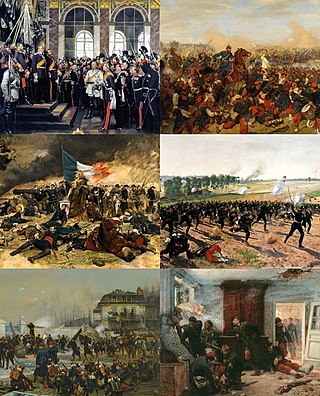
The Franco-Prussian War or Franco-German War, often referred to in France as the War of 1870, was a conflict between the Second French Empire and the North German Confederation led by the Kingdom of Prussia. Lasting from 19 July 1870 to 28 January 1871, the conflict was caused primarily by France's determination to reassert its dominant position in continental Europe, which appeared in question following the decisive Prussian victory over Austria in 1866. According to some historians, Prussian chancellor Otto von Bismarck deliberately provoked the French into declaring war on Prussia in order to induce four independent southern German states—Baden, Württemberg, Bavaria and Hesse-Darmstadt—to join the North German Confederation; other historians contend that Bismarck exploited the circumstances as they unfolded. All agree that Bismarck recognized the potential for new German alliances, given the situation as a whole.
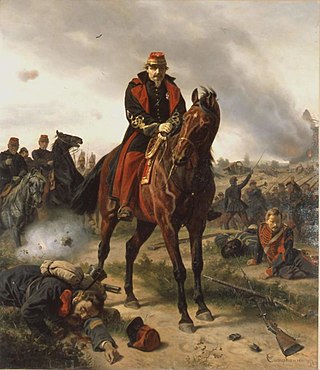
The Battle of Sedan was fought during the Franco-Prussian War from 1 to 2 September 1870. Resulting in the capture of Emperor Napoleon III and over a hundred thousand troops, it effectively decided the war in favour of Prussia and its allies, though fighting continued under a new French government.

Alphonse-Marie-Adolphe de Neuville was a French academic painter who studied under Eugène Delacroix. His dramatic and intensely patriotic subjects illustrated episodes from the Franco-Prussian War, the Crimean War, the Zulu War, and portraits of soldiers. Some of his works have been collected by the Hermitage Museum in St. Petersburg and by the Metropolitan Museum in New York.

The siege of Paris took place from 19 September 1870 to 28 January 1871 and ended in the capture of the city by forces of the various states of the North German Confederation, led by the Kingdom of Prussia. The siege was the culmination of the Franco-Prussian War, which saw the Second French Empire attempt to reassert its dominance over continental Europe by declaring war on the North German Confederation. The Prussian-dominated North German Confederation had recently emerged victorious in the Austro-Prussian War of 1866, which led to the questioning of France's status as the dominant power of continental Europe. With a declaration of war by the French parliament on 16 July 1870, Imperial France soon faced a series of defeats at German hands over the following months, leading to the Battle of Sedan, which, on 2 September 1870, saw a decisive defeat of French forces and the capture of the French emperor, Napoleon III.

The Battle of Le Mans was a German victory during the Franco-Prussian War that ended French resistance in western France.
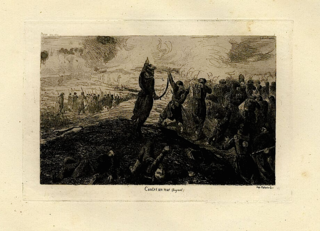
The (Second) Battle of Buzenval, also known as the Battle of Mont Valérien, was part of the siege of Paris during the Franco-Prussian War. On 19 January 1871, the day after Wilhelm I was proclaimed German Emperor, Louis Jules Trochu attacked the Germans west of Paris in Buzenval Park. The attackers seized the town of Saint-Cloud, coming close to the new Emperor's headquarters at Versailles. Trochu was able to maintain his position at St. Cloud for most of the day, but the failure of other French forces to hold their positions left him isolated and the Crown Prince's army was able to force Trochu's salient back into Paris by the next day. This was the last effort to break out of Paris. Trochu turned over command of the Paris defenses to Joseph Vinoy who surrendered the city ten days later.

The Battle of Villiers, also called the Battle of Champigny, was the largest of the French sorties from besieged Paris during the Franco-Prussian War.

The first Battle of Verdun was fought between 29 August and 2 September 1792 between French Revolutionary forces and a Prussian army during the opening months of the War of the First Coalition. The Prussians were victorious, gaining a clear westward path to Paris.

The Government of National Defense was the first government of the Third Republic of France from 4 September 1870 to 13 February 1871 during the Franco-Prussian War. It was formed after the proclamation of the Republic in Paris on 4 September, which in turn followed the surrender and capture of Emperor Napoleon III by the Prussians at the Battle of Sedan. The government, headed by General Louis Jules Trochu, was under Prussian siege in Paris. Breakouts were attempted twice, but met with disaster and rising dissatisfaction of the public. In late January the government, having further enraged the population of Paris by crushing a revolutionary uprising, surrendered to the Prussians. Two weeks later, it was replaced by the new government of Adolphe Thiers, which soon passed a variety of financial laws in an attempt to pay reparations and thus oblige the Prussians to leave France, leading to the outbreak of revolutions in French cities, and the ultimate creation of the Paris Commune.
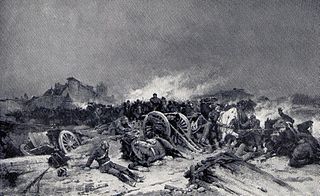
The Battle of Beaune-la-Rolande on 28 November 1870 took place during the Franco-Prussian War, which was won by Prussia. In an attempt to relieve the Siege of Paris, French General Crouzat's XX Corps launched an attack against three Prussian brigades resting in Beaune-la-Rolande. These brigades were from the Prussian X Corps which was detailed to guard the flanks and rear of the force besieging Paris and provide early warning of any French counter-attacks. The French committed a force of 60,000 men, largely conscripts of the Garde Mobile, and 140 guns against the Prussians' 9,000 men and 70 guns, mostly drawn from regular troops, although military historian Gaston Bodart estimated their strength at 40,000 men and 174 guns. Despite the superiority of numbers the French attack failed to take the village and was ultimately forced to retreat by Prussian reinforcements.

The Battle of Villepion took place between the French XVI Corps under General Chanzy and the I Bavarian Corps during the Franco-Prussian War. It occurred in the district of Terminiers, between Terminiers and Nonneville on 1 December 1870, and ended in a French victory.
The Battle of Châtillon, also known as the Battle of Châtillon-sous-Bagneux, was a skirmish in the Siege of Paris between France and North German Confederation in the Franco-Prussian War, took place on 13 October 1870. This is also considered the first battle in the history of the French Third Republic. In this fierce battle – occurred at Châtillon and Sceaux, Corps V of the Prussian army under the command of Lieutenant General Infantry Hugo von Kirchbach, along with the II Corps of the Kingdom of Bavaria by the Supreme Minister infantry Jakob von Hartmann which were the forces of the army Group 3 of Prussia by Prince Friedrich Wilhelm as General command., won a victory against an attack by the XIV Corps under General Renault - of the French army under General Auguste-Alexandre Ducrot. Although some soldiers under Ducrot fought well, the majority of his army became agitated. The French were forced to flee to Paris, losing the Châtillon Plateau - a very favorable defensive position overlooking the fortresses south of Paris - to the Germans. This was a disaster for the "justice" of the French army during the war, although the French reported that they suffered only minor losses.
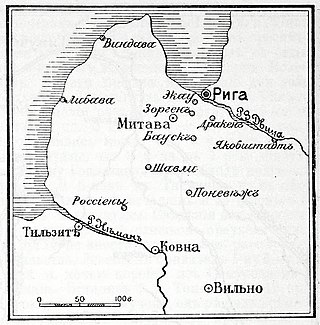
The Battle of Mesothen took place from 26-30 September to 1 October 1812, between the Russian Corps of Finland and the French-allied Prussian Auxiliary Corps. It was fought near the Latvian town of Mežotne, then part of the Courland Governorate.
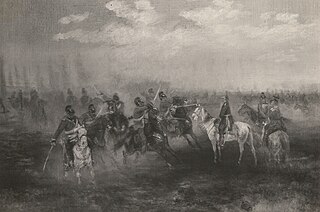
Battle of Buzancy was a battle of the Franco-Prussian War which took place on 27 August 1870 in Buzancy, France between the French Empire and the combined German forces of Prussia and Saxony. The midfield force of the 24th Brigade of a division Saxon cavalry of the Maas Army of the Prussian army won a victory over the Cavalry Regiment. 12th Chasseur light infantry of the V Army of the French Empire under the command of General Pierre Louis Charles de Failly. Taken by surprise in this cavalry battle, the French formation was torn apart and almost completely annihilated. On the Prussian - German side, the captains of the two cavalry squadrons involved in the battle were wounded. The defeat at Buzancy forced the retreat of the French cavalry squadrons, and the Battle of Buzancy is arguably the most characteristic cavalry and artillery clash of the war.

The siege of Montmédy was a battle of the Franco-Prussian War at the small commune of Montmédy, in the Meuse, it was besieged by the army of the German coalition. Defended by the 57th Line Infantry Regiment, the Garde Mobile and elements of other units, it surrendered on December 14, 1870.
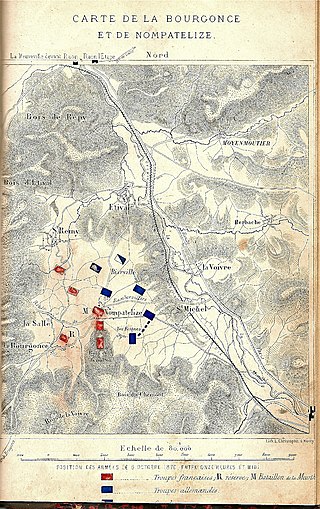
The Battle of Nompatelize, also known as the Battle of Etival, was a battle of the Franco-Prussian War on 6 October 1870, between Etival and Nompatelize in the province of Vosges from Strasbourg 64 km southwest. This battle marked the first major crackdown of franc-tireur operations in the Vosges region by the XIV Corps of the Prussians by Minister August von Werder in early October 1870. In matches fiercely this, A force of the Army of Rhône of the French Republic under the command of General Louis-François Dupré, who predominated to markedly document in terms of troop numbers, and attacked 6 infantry battalions of the Grand Duchy of Baden under the command of General Alfred von Degenfeld which were part of the XIV Corps, but were defeated. Compared to the casualties of the German military, the losses of the French side in this battle were much greater. After seven hours of fighting, the French were forced to flee in turmoil to Bruyeres and the Rambervillers. The Battle of Etival contributed to General Werder wiping out the French from Alsace.
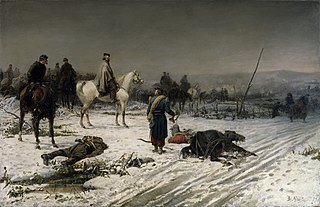
The Battles of Dijon were a series of battles that took place in 1870 and 1871, as part of the Franco-Prussian War, on the current territory of the French commune of Dijon between the French Republic and the German states of Prussia and Baden and later, the German Empire.

The Battle of Artenay' also known as the Battle of Arthenay, took place during the Franco-Prussian War, on October 10, 1870, in Artenay a small town located on the road from Orléans to Paris, France which was about 10 miles north of the city of Orléans. In this fierce battle, with superior strength compared to the opponent, The I Corps of the Kingdom of Bavaria, under the command of Lieutenant General Ludwig von der Tann-Rathsamhausen, in collaboration with the 22nd Division of the XI Corps of the Kingdom of Prussia and the two cavalry divisions of the Prussian army attacked and penetrated the defense system of the army of the Loire of the young French Republic, under the control of general Joseph Edouard de la Motterouge, causing heavy losses for the French military of which many people were taken prisoner. The winning conditions Artenay were favorable enough for Von der Tann to strike Orléans, while the forces of France knocked back on Orléans forest in an agitated state. Despite this, Nièvre's Garde Mobiles and the Pontifical Legion in the French army were noted for their strong resistance, while a monk in Prussian Cavalry under the command of Prince Albrecht demonstrated his prowess in the battle at Artenay.

Adrien Alexandre Adolphe de Carrey de Bellemare, more commonly known as Carey de Bellemare, was a French Divisional General who was most notable for his service during the Franco-Prussian War.
On October 31, 1870, a popular insurrection occupied Paris's City Hall. Amidst the Franco-Prussian War, Parisians simultaneously heard of losses at Le Bourget and Metz alongside armstice negotiations. Incensed by what they viewed as treason, a group of 300 to 400 demonstrated at the City Hall and members of the left-wing National Guard captured and occupied the building with several members of the Government of National Defense inside.


















